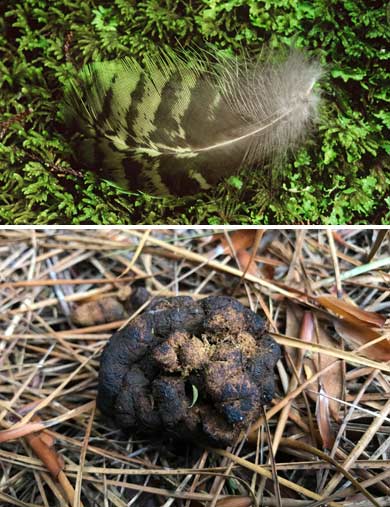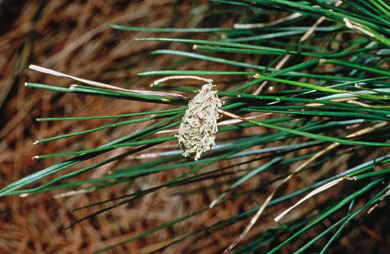How to spot a kākāpō
Introduction
Keep an eye out for kākāpō sign when you’re in remote areas of New Zealand.It’s possible, though unlikely, that a few kākāpō survive in southern Stewart Island/Rakiura or in remote parts of Fiordland. We encourage visitors to these areas to look out for feeding sign, and to listen for kākāpō calls.
If there's enough evidence from the area that a kākāpō is present, a search will be initiated. The type of evidence we need might include a feather, dropping or feeding sign.
Where to look
Kākāpō habitat is varied. Most sign is likely to be found on hill tops or ridge crests – places where male kākāpō make their track-and-bowl systems.
What to look for

Kākāpō feather (top) and dropping
Images: Don Merton, Andrew Digby | DOC
Feathers
Kākāpō feathers are pale yellow or moss green, irregularly barred with black, brown or yellow. When freshly shed, the feathers may have a distinctive musty smell.
Droppings
Kākāpō droppings vary in colour and consistency but are typically green to dark brown, firm, and 25–50 mm in diameter – about the size of a large hen dropping.
They are nearly always made up of long, intertwined spaghetti-like sections, with a partial white coating. They have a herby, inoffensive smell when fresh.
Droppings are usually found in roosting places: beneath overhanging rocks, in small caves, in holes beneath tree roots, or under dense vegetation. They last for decades in dry places.
Tracks
Male kākāpō maintain tracks in their display grounds by clipping off vegetation. The tracks are most noticeable on the crests of ridges and spurs in scrub and tussock country, near the forest edge. They are well defined, and 30–60 cm wide.
Tracks may persist for years after kākāpō have gone. Or they may show little sign of use for long periods, even when kākāpō are present.
Bowls

An active kākāpō bowl
Image: Don Merton | DOC
If a track has bowl-shaped depressions at intervals along its length, it’s almost certainly been made by kākāpō. Bowls are always connected by tracks.
Bowls are often formed against a boulder or at the base of a tree or shrub. They are 45–60 cm in diameter, and up to 10 cm deep. They are usually found in groups, extending in a line up a ridge or dispersed over the top of a knoll.
If a bowl is in use, the area will become a scene of intense nocturnal activity during summer months. The bowls will show considerable signs of trampling and grubbing. There will also be signs of gnawing on nearby roots and branches.
Anyone camped in the vicinity will hear booming and other strange noises at night.
Feeding sign

A kākāpō chew on a pine sprig
Image: Don Merton | DOC
Kākāpō chews are a tell-tale sign of kākāpō feeding.
What to listen for
‘Booming' is the most characteristic kākāpō call. It’s produced by males at night during breeding summers.
Kākāpō male 'booms' (MP3, 2,102K)
02:14 – Adult male 'booming' to attract females.
Report a kākāpō
If you’ve seen kākāpō sign, contact us at kakaporecovery@doc.govt.nz or call on +64 3 2112 400.
